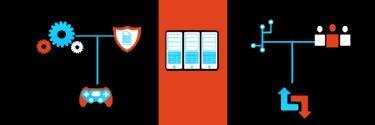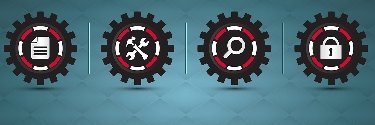Development tools for continuous software delivery
Software developers build applications faster when they have the right tools. Review the essential tools every software developer needs, such as Git, Jenkins, IDEs such as Eclipse and build tools including Maven and Gradle. Also, gain insight into how AI and machine learning are pushing software development tool capabilities to new levels to help developers generate quality code.
Top Stories
-
Quiz
16 Sep 2025

More AWS Cloud Practitioner practice exam questions
Ready to take the next step in your cloud career? These AWS cloud practitioner practice exam questions will test your knowledge about key AWS services and capabilities. Continue Reading
By- Cameron McKenzie, TechTarget
-
Quiz
04 Sep 2025

10 questions for AWS Certified Cloud Practitioner exam prep
Technical IT professionals could benefit from an AWS Certified Cloud Practitioner certification on their resume. These 10 questions can help gauge your exam readiness. Continue Reading
By- Cameron McKenzie, TechTarget
-
Answer
27 Oct 2020

How can I become an AWS Authorized Instructor?
To become an AWS Authorized Instructor, you need deep knowledge of Amazon products and services and must be able to communicate this wealth of technical information. Continue Reading
By- Hiren Dossani
-
Feature
12 Oct 2020

5 helpful tips to reduce webpage load time, improve performance
Nobody wants to wait for a webpage to load. Follow these tips to reduce website load time and improve the user experience for a better online persona. Continue Reading
By- Tim Culverhouse, Site Editor
-
Infographic
01 Oct 2020

How the process automation industry has changed during COVID-19
Process automation can help corporate budget planners cut costs and create efficiencies in the wake of the COVID-19 pandemic. Expect companies that sell these tools to see significant growth in these times. Continue Reading
By- Cameron McKenzie, TechTarget
-
Feature
30 Sep 2020

Is Apache Tomcat the right Java application server for you?
What is the best application server? The answer depends on what an enterprise is looking for. Compare Apache Tomcat to these four offerings to see which Java app server fits. Continue Reading
By- Tim Culverhouse, Site Editor
-
Video
02 Sep 2020

How to git stash untracked files with a push
Need to add untracked files and otherwise ignored files into the git stash? Here's how to use the --include-untracked and --all git stash push options. Continue Reading
By- Cameron McKenzie, TechTarget
-
News
24 Aug 2020

Microsoft makes TypeScript 4 generally available
Microsoft has made TypeScript 4 generally available for developers building large systems in JavaScript. TypeScript, a superset of JavaScript, is designed for the enterprise. Continue Reading
-
Opinion
13 Aug 2020

5 must-listen Joe Rogan Experience podcasts for programmers
Most listeners won't expect the Joe Rogan Experience podcast to delve into topics for developers and programmers, but these five episodes are of special interest to IT professionals. Continue Reading
By- Cameron McKenzie, TechTarget
-
Video
30 Jul 2020

Tomcat vs. JBoss: Compare features of these Java app servers
How do Apache Tomcat and RedHat's JBoss EAP server compare? Evaluate the features of each application server to find the one that makes sense for your enterprise. Continue Reading
By- Cameron McKenzie, TechTarget
-
Podcast
27 Jul 2020

How Quarkus fits into the Red Hat Runtimes formula
Faster microservices runtimes are the center of the excitement around Quarkus. Hear what Red Hat's James Falkner thinks about the framework in this podcast with TheServerSide.com. Continue Reading
By- Cameron McKenzie, TechTarget
-
Tip
13 May 2020

The Ben Franklin Effect and software developer career advice
Are you a new programmer in need of a quick and simple way to blend in with your team? Here's some career advice from none other than Benjamin Franklin that might help you do just that. Continue Reading
By- Cameron McKenzie, TechTarget
-
Opinion
30 Apr 2020

Use a developer desktop setup instead of a laptop
Don't get hung up on a laptop for software development, even if you work best from the couch. Here are six reasons why desktops, instead of laptops, should be provided to developers. Continue Reading
By- Cameron McKenzie, TechTarget
-
News
01 Apr 2020

Eclipse launches Theia 1.0 as alternative to VS Code
The Eclipse Foundation's Theia framework for building desktop and cloud IDEs has the potential to be as big as the initial release of the Eclipse IDE itself nearly 20 years ago. Continue Reading
-
Tip
28 Feb 2020

5 tips to reduce webpage weight and improve user experience
A slow landing page makes a bad first impression for any potential website visitor. Here are five tips to improve the page and increase page load speeds. Continue Reading
By- Cameron McKenzie, TechTarget
-
Video
24 Feb 2020

How to use the git clone command with GitHub by example
Move code from remote-hosted version control repositories into local ones with one command. Follow this Git clone tutorial to move code into local environments. Continue Reading
By- Cameron McKenzie, TechTarget
-
Video
19 Nov 2019

How to run Java preview features such as JDK 13 text blocks
Follow these five steps to enable the JDK 13 text blocks as part of the preview features in the latest Java release and use multi-line String literal in your code. Continue Reading
By- Cameron McKenzie, TechTarget
-
Video
24 Oct 2019

Tomcat vs. Apache HTTP Server: What's the difference?
Don't get caught up in the improper phrasing of "What's the difference between Tomcat and Apache?" Let's straighten out the confusion and compare the two server offerings. Continue Reading
By- Cameron McKenzie, TechTarget
-
Opinion
17 Oct 2019

Is Java slow? Compared to C++, it's faster than you think
If you find that Java is slower than other languages, such as C++, here's how to better compare the two and the major differences between compiled and interpreted languages. Continue Reading
By- Cameron McKenzie, TechTarget
-
News
09 Oct 2019

Pivotal, Microsoft team up to deliver Azure Spring Cloud
Azure Spring Cloud, jointly developed by Microsoft and Pivotal, lets Spring developers bring apps to the cloud without concern for the underlying cloud infrastructure. Continue Reading
-
Feature
17 Sep 2019

Cloud marketplace as a service creates new dev possibilities
A neutral cloud marketplace would allow developers to pick and choose applications, without the constraints of one cloud. What could that mean for you? Continue Reading
-
News
17 Sep 2019

Java SE 13 adds performance, security, stability features
Java SE 13 provides developers with new features to make the Java language and platform more secure and stable. Oracle has also rolled out free cloud services and developer tools. Continue Reading
-
Feature
27 Aug 2019

Top Java programming tools used in application development
There's a multitude of Java tools that help the software development process. Here's a list of Java tools and technologies that every programmer should be aware of. Continue Reading
By- Cameron McKenzie, TechTarget
-
Feature
31 Jul 2019

Follow these best practices on how to write clean code in Java
Follow these three best practices to write clean Java code and help make your application development simple and painless for all parties involved in the process. Continue Reading
By -
Opinion
30 Jul 2019

What's the future of WebSphere Portal as HCL acquires IBM products?
WebSphere users can breathe easy after its acquisition by HCL was finalized in July 2019. The platform will receive heavy investment from its new caretakers. Continue Reading
By- Sal Pece
-
Video
28 Jun 2019

Hibernate vs. JDBC: How do these database APIs differ?
Don't overthink it. Hibernate and JDBC aren't the same thing. But how do these database APIs differ? Here's a brief history lesson and explainer to find out. Continue Reading
By- Cameron McKenzie, TechTarget
-
Video
26 Jun 2019

Best Java static code analysis tools for code quality automation
Don't let faulty code bring down your software project. These Java code quality tools can help find and fix common errors before they become problems. Continue Reading
By- Cameron McKenzie, TechTarget
-
Video
18 Jun 2019

Java command-line interface tools every JDK developer should know
These five JDK tools -- javac, javap, jstat, jdeps and jar -- should be on the must-know list for every developer to help comprehend the underlying code in a project. Continue Reading
By- Cameron McKenzie, TechTarget
-
Definition
29 May 2019

Java Database Connectivity (JDBC)
Java Database Connectivity (JDBC) is an API packaged with the Java SE edition that makes it possible to connect from a Java Runtime Environment (JRE) to external, relational database systems. Continue Reading
By- Cameron McKenzie, TechTarget
-
Feature
15 May 2019

Don't let plugins open up more Jenkins vulnerabilities
Let's explore the Blue Ocean, Config File Provider and Groovy plugins with security vulnerabilities. Here's how to address them, and what could happen if you don't. Continue Reading
-
Definition
30 Apr 2019

Java virtual machine (JVM)
A Java virtual machine (JVM), an implementation of the Java Virtual Machine Specification, interprets compiled Java binary code (called bytecode) for a computer's processor (or "hardware platform") so that it can perform a Java program's instructions. Continue Reading
-
News
18 Apr 2019

Red Hat replaces Oracle as OpenJDK 8, OpenJDK 11 steward
Red Hat has taken control of two popular versions of the open source Java implementation, so developers can continue to build apps after Oracle's support ends. Continue Reading
-
Definition
16 Apr 2019

full-stack developer
A full-stack developer is a type of programmer that has a functional knowledge of all techniques, languages and systems engineering concepts required in software development. Continue Reading
By -
Feature
20 Mar 2019

Find the right model for developing AI applications
Developing AI apps isn't a walk in the park. Here's a guideline on how it differs from traditional application development and what your IT teams need to be aware of. Continue Reading
-
Definition
13 Mar 2019

Java Runtime Environment (JRE)
The Java Runtime Environment (JRE), also known as Java Runtime, is the part of the Java Development Kit (JDK) that contains and orchestrates the set of tools and minimum requirements for executing a Java application. Continue Reading
By -
Video
26 Feb 2019

Don't git revert that last commit, git reset instead
Developers should only use git revert if they need to reverse out a specific change in their code. To simply undo a previous commit to a shared repository, use git reset instead. Continue Reading
By- Cameron McKenzie, TechTarget
-
Feature
14 Jan 2019

Want a private GitHub repository? It comes with a catch
Want a private GitHub repo? You can now create one with a basic account, but the feature set is somewhat limited. Continue Reading
By- Cameron McKenzie, TechTarget
-
Feature
28 Dec 2018

Java developer tutorials a popular destination for 2018 readers
What were readers interested in during 2018? Java developer tutorials topped the list. Learn how to integrate RESTful APIs, GIT, and Jenkins CI tools. Continue Reading
By- Cameron McKenzie, TechTarget
-
Feature
03 Dec 2018

Static analysis of Java via the Checkstyle plugin for Eclipse
The best way to preserve your code quality is to routinely run static code analysis from your IDE. Here's a tutorial on how to do this with the Checkstyle plugin for Eclipse. Continue Reading
By- Cameron McKenzie, TechTarget
-
Feature
30 Oct 2018

This history of GitHub and Java's role in it
Ruby played a big role in the history of GitHub, but Java now plays a bigger part. At Oracle Code One, GitHub engineering manager Rafer Hazen provided plenty of reasons why. Continue Reading
By- Cameron McKenzie, TechTarget
-
Opinion
22 Oct 2018

4 reasons why Gradle may be the right Java build tool
When it comes to building Java projects, developers need to pick the right tool for the job. Gradle separates itself from the pack with its emphasis on plugins and flexibility. Continue Reading
By -
Video
18 Sep 2018

How to set up and use a JFrog Artifactory as a local Maven repository
In this Artifactory tutorial, we'll show you how to deploy JAR files to an Artifactory Maven repository. It's surprisingly simple. Continue Reading
By- Cameron McKenzie, TechTarget
-
Feature
13 Sep 2018

When you compare Java build tools, Maven comes out on top
What is the best Java build tool on the market? Is it Gradle? Do people still use Ant? Here, we explore why Maven is still one of the industry's most popular Java build tools. Continue Reading
By -
News
11 Jul 2018

Financial firms, vendors push self-service software delivery
Self-service DevOps automation appeals to enterprises that must push out new code as they adapt to changing requirements. Continue Reading
-
Feature
14 May 2018

Automated Java testing tools source code developers need to know
How do Selenium, Junit, Grinder and other automated testing tools work? This guide to explains how these tools work and what you can learn from them for Java unit testing, integration testing, load testing and more. Continue Reading
By -
Tutorial
09 May 2018

How to install Maven and build apps with the mvn command line
If you want to learn Maven and become a build master, the first step is to install Maven, and the second is to use the mvn command-line tool to compile and package Java apps. Continue Reading
By- Cameron McKenzie, TechTarget
-
Feature
27 Apr 2018

Build secure coding practices right into the IDE
Tools that integrate secure coding practices into the IDE promise to improve software security, even if the app in question isn't secure by design. Continue Reading
-
News
25 Apr 2018

Google Stackdriver APM enhances app monitoring
Additional profiling, debugging and tracing tools for Google's Stackdriver suite expand application performance management services for developers. Continue Reading
-
Feature
20 Apr 2018

New IDE tools to visualize code may accelerate app dev
IDE tools for code visualization have always been difficult to implement. But given the benefits, new tools have emerged to make it possible to easily visualize your code. Continue Reading
-
Podcast
17 Apr 2018

Let's talk bitcoin and building blockchain apps fast with Hyperledger
If you're thinking about building blockchain apps, you're probably looking for the right tools and technologies. Hyperledger Fabric and Composer just might meet your requirements. Continue Reading
By- Cameron McKenzie, TechTarget
-
News
02 Mar 2018

Simplified automated cloud deployment with Bitnami's Stacksmith
Looking to do automated cloud deployment, or even help with security updates to your apps running in Docker containers? Bitnami's recently released Stacksmith promises to do just that. Continue Reading
By- Cameron McKenzie, TechTarget
-
News
22 Feb 2018

IBM hones in on AI talent at developer confab
IBM and others target developers interested in building artificial intelligence applications, as the number of skilled AI developers falls short of industry needs. Continue Reading
-
News
16 Feb 2018

Pluralsight IQ, Stack Overflow boost developer street cred
Tying the Pluralsight IQ skills test to the Stack Overflow Developer Story helps developers measure their technical skills and better highlight them for jobs. Continue Reading
-
News
12 Jan 2018

AWS Cloud9 IDE threatens Microsoft developer base
With its Cloud9 IDE, AWS challenges Microsoft where it matters most -- with the developer community, where Microsoft has long-held sway. Continue Reading
-
Feature
27 Dec 2017

New distributed tracing API completes the feedback loop
As apps get moved to the cloud and software has no fixed address, tracing and troubleshooting are challenges. However, a new distributed tracing API promises to simplify things. Continue Reading
-
Feature
20 Nov 2017

How to solve JavaScript and Java performance issues
Given the complexity of client side user interfaces, along with the often limited processing power of many mobile devices, finding out ways to address JavaScript and Java performance challenges is a priority. Continue Reading
By- Tom Nolle, Andover Intel
-
Definition
29 Sep 2017

Java assert
The Java assert is a mechanism used primarily in nonproduction environments to test for extraordinary conditions that will never be encountered unless a bug exists somewhere in the code. Continue Reading
By- Cameron McKenzie, TechTarget
-
Feature
28 Aug 2017

Improve your user engagement metrics with emotional analytics
Find out how new emotion analytics algorithms are bringing feeling, emotional connection, and engagement to modern apps. Continue Reading
-
Feature
05 Jul 2017

Java DevOps provides Agile path to continuous delivery success
While there are many competing software development languages, Java DevOps has continued to prove itself as a means for successfully implementing continuous delivery systems. Continue Reading
By- Tom Nolle, Andover Intel
-
Feature
05 Jul 2017

Keep your Java cloud apps running during an Amazon S3 outage
Many people had to learn the hard way that an Amazon S3 outage is possible. Here we look at how to keep your Java cloud apps running, even if the Amazon cloud isn't. Continue Reading
-
Feature
28 Jun 2017

How Pokemon Go needed a Kubernetes powered Java cloud
How did Pokemon Go scale so well? A big part of its scalability was the Java cloud platform that leveraged containers and Kubernetes. Continue Reading
-
News
22 May 2017

Atlassian spurs DevOps adoption for the enterprise
Atlassian adds new features to Bitbucket and Bamboo to enhance DevOps security and reliability, as well as to simplify the build process for developers. Continue Reading
-
Podcast
17 May 2017

Continuous delivery book asserts automation is key to effective DevOps
While interviewing Eberhard Wolff about his practical continuous delivery book, it's clear that effective DevOps adoption means full test coverage and pipeline automation. Continue Reading
By- Cameron McKenzie, TechTarget
-
Feature
14 May 2017

Improving DevOps automation with continuous delivery chain acceleration
DevOps teams must do more than just DevOps automation. To improve DevOps, continuous delivery chain acceleration is essential. Continue Reading
By -
Feature
21 Apr 2017

Being Java cloud native means more than containers and microservices
Many traditional developers are worried that the cloud-native trend is leaving them behind. Fortunately, help is on its way to make existing code more Java cloud native compliant. Continue Reading
By- Cameron McKenzie, TechTarget
-
News
19 Apr 2017

Oracle Code conference a worthwhile investment for full-stack developers
Oracle Code is a software conference that both promotes Oracle's cloud computing message, while providing useful knowledge to full-stack developers. Continue Reading
By- Cameron McKenzie, TechTarget
-
Feature
17 Apr 2017

Tips for avoiding external and internal API performance issues
After convincing users to integrate into your system, the last thing you want is for them to suffer from API performance issues. Ensure users that API performance isn't a problem. Continue Reading
By- Zachary Flower, Freelance web developer and writer
-
Podcast
03 Apr 2017

Container tools fighting hard to keep up with the Docker trend
Tooling often lags behind big technology trends, which is why the container tools industry is being forced to mature quickly as Docker adoption takes off. Continue Reading
By- Cameron McKenzie, TechTarget
-
Opinion
16 Mar 2017

Amazon S3 outage a Fukushima moment for cloud computing
The Amazon S3 outage has turned into the Fukushima moment of cloud computing, as users re-evaluate the cloud's long-term viability. Continue Reading
By- Cameron McKenzie, TechTarget
-
Feature
13 Mar 2017

GPU computing key to machine learning and big data performance
While the CPU remains central to data processing, massive gains in the area of AI analytics and dig data performance are being seen when GPU computing is thrown into the mix. Continue Reading
By- Daisy McCarty, Brand Message Clarity
-
Feature
02 Mar 2017

JavaScript front-end frameworks, TypeScript skills in demand in 2017
What's hot in software in 2017? In JavaScript front-end frameworks, its TypeScript and componentized front-end web app development, says Progress expert. Continue Reading
By- Jan Stafford, Features Writer
-
Feature
01 Mar 2017

IoTaaS? Clearing the roadblocks to IoT-as-a-Service adoption
It would appear that everything is available as-a-Service these days, so why not IoTaaS? Here's what's hindering IoT-as-a-Service adoption. Continue Reading
By -
News
17 Feb 2017

Pass on the JSON, and choose binary encoding formats instead
Find out how developers can achieve significant performance boosts using new binary encoding formats as alternatives to JSON and XML. Continue Reading
-
Feature
27 Oct 2016

SVG graphics and HTML5 key to creating consistent UIs across devices
Find out how new libraries and tools promise to bring a consistent UI with SVG graphics in HTML5 development. Continue Reading
-
Feature
29 Sep 2016

How embedded technologies are enabling the Internet of Things (IOT)
From wearable devices to internet connected devices called NodeBots, embedded technologies are enabling the development of all of the cool, new devices that are colloquially being referred to as the Internet of Things (IOT). Continue Reading
By -
News
20 Sep 2016

JShell: Adding REPL capabilities to the JDK
At JavaOne 2016, Oracle's chief architect of the Java platform group, Mark Reinhold, discusses the addition of JShell. Learn why he's excited. Continue Reading
By- Cameron McKenzie, TechTarget
-
Opinion
12 Aug 2016

Could someone please provide a proper toString() method implementation?
Why is it that twenty years after the release of Java, the lapidary toString() method still spits out nothing more than a useless hashcode? Continue Reading
By- Cameron McKenzie, TechTarget
-
Blog Post
08 Aug 2016

Git Tutorial – The Ultimate Guide
Git is, without any doubt, the most popular version control system. Ironically, there are other version control systems easier to learn and to use, but, despite that, Continue Reading
By- ilias tsagklis
-
Podcast
04 Aug 2016

Gil Tene extols the benefits of hardware transactional memory at QCon
Everyone likes a feature that improves performance out of the box, which is why hardware transactional memory has become such a hot topic at QCon 2016 Continue Reading
By- Cameron McKenzie, TechTarget
-
Opinion
27 Jul 2016

Technical debt is not scary if you invest it well
Many are scared off by the prospect of technical debt, but the flipside of debt is often the acquisition of an asset. Joe Ottinger explains why technical debt isn't always scary. Continue Reading
By- Joseph B. Ottinger, EnigmaStation
-
Podcast
26 Jul 2016

What's new in the Jenkins 2.0 continuous integration tool release?
Jenkins 2.0 is the latest, full increment release of the world's most downloaded continuous integration tool. Here we look at what's new and why you should upgrade. Continue Reading
By- Cameron McKenzie, TechTarget
-
News
15 Jun 2016

Will server hardware perform faster with transactional memory?
For many Java applications doing list processing, having transactional memory built right into Intel's commodity CPUs will result in greater server hardware performance. Continue Reading
By- Cameron McKenzie, TechTarget
-
News
16 May 2016

Beachbody pumps up application performance monitoring tools
Costly website and app downtime spurred an application performance monitoring tools makeover at Beachbody. Learn how the fitness firm chose and deployed new APM tools. Continue Reading
By- Jan Stafford, Features Writer
-
Feature
10 May 2016

Make predictive monitoring effective for your organization
The ability to anticipate an issue with predictive monitoring outweighs the value of performance monitoring. Chris Riley discusses further. Continue Reading
By- Chris Riley, Fixate IO
-
Feature
20 Apr 2016

Using BackOps to improve software development processes
Learn how BackOps understands different personality types and can improve the software development lifecycle and scale the enterprise. Continue Reading
-
News
11 Apr 2016

Improving Web app performance as simple as embracing HTTP/2
Learn about how the rapidly growing HTTP/2 protocol can improve Web app performance and reduce development headaches. Continue Reading
-
Feature
25 Mar 2016

The five keys to mastering software analytics, logging and reporting
Simply turning on an analytics engine, going over logs and generating a report isn't enough to understand your software. Here are five keys to getting the most out of your analytics. Continue Reading
By- Swathija Raman
-
Feature
21 Mar 2016

Make SCM tool Git the easiest part in a DevOps transition
One of the first changes made by organizations engaging in a DevOps transition is using Git. Here are five tips to help simplify the adoption of the SCM tool. Continue Reading
By- Cameron McKenzie, TechTarget
-
Feature
16 Feb 2016

Five drawbacks to choosing JSF as your web application framework
Being packed as part of the Java EE web profile, JSF is a compelling web framework to choose, but here are five reasons why you might want to think twice about using JavaServer Faces as UI framework for your project. Continue Reading
By- Cameron McKenzie, TechTarget
-
Feature
03 Feb 2016

Choosing the right DevOps tool to tame your polyglot programming
When programs are built using a polyglot of different languages, organizations need good DevOps tools to manage that integration. Continue Reading
By- Chris Riley, Fixate IO
-
Feature
11 Jan 2016

The top software picks for making Windows 10 workstations productive
What software do you need to install on a Windows 10 machine to create an incredible, full featured, desktop computer that allows you to do everything you want? Here's our top software picks. Continue Reading
By- Cameron McKenzie, TechTarget
-
News
18 Dec 2015

Social business applications entice, but enterprises are skeptical
Alan Pelz-Sharpe discusses social business applications and why businesses are wary of this strategy. Continue Reading
By- Jan Stafford, Features Writer
-
News
09 Dec 2015

Exploring a software architect's favorite Oracle JavaFX tools
At JavaOne 2015, Java enthusiast Rob Terpilowski discusses why he's still a fan of Oracle JavaFX tools. Continue Reading
By- Jan Stafford, Features Writer
-
News
08 Dec 2015

Did Android applications save Java? Expert weighs in
Barry Burd, Java expert and author, discusses how Android applications may have brought Java back from the brink. Continue Reading
By- Cameron McKenzie, TechTarget
-
News
04 Dec 2015

Java whiz Barry Burd discusses Greenfoot programming
Learn more about Greenfoot programming from Java pro Barry Burd. Continue Reading
By- Cameron McKenzie, TechTarget
-
Feature
02 Dec 2015

How to build an application integration framework for flexibility
Learn how MOBI Wireless created a back end infrastructure that makes it easy to implement different business workflows across service providers. Continue Reading
-
News
20 Nov 2015

Pressure to hire Java developers intensifies in Seattle
To hire Java developers, Seattle software architect Rob Terpilowski has to compete against local heavyweights like Amazon. Continue Reading
By- Jan Stafford, Features Writer
-
Podcast
06 Oct 2015

Productivity tools in growing lightweight architectures
ZeroTurnaround developer advocate Simon Maple discussed the most important productivity tools, including WebSphere. Continue Reading
By- Cameron McKenzie, TechTarget
-
Podcast
25 Sep 2015

XRebel changes application performance monitoring tools
In this podcast, ZeroTurnaround's Jevgeni Kabanov discusses how XRebel differentiates itself from competing application performance monitoring tools on the market. Continue Reading
By- Cameron McKenzie, TechTarget
-
Podcast
09 Sep 2015

Improving developer productivity with ZeroTurnaround
In this podcast, Anton Arhipov and Geert Bevin talk about ZeroTurnaround's legacy of delivering tools that improve developer productivity. Continue Reading
By- Cameron McKenzie, TechTarget
-
Feature
09 Jul 2015

Addressing the SPI performance issues you don't realize you already have
New frameworks like Angular and Ember make creating applications with a single-page-interface (SPI) easier than ever. But quite often the performance feedback never gets back to the server, especially given the fact that all of that code runs on the client. Here's how to deal with the SPI performance problems you didn't know you had. Continue Reading
By -
News
26 Jun 2015

OpenShift set to revolutionize PaaS platforms
OpenShift not only revolutionizes PaaS platforms, it embraces DevOps by creating tools and advancing technologies that simplify operations professionals' lives. Continue Reading
By- Cameron McKenzie, TechTarget


